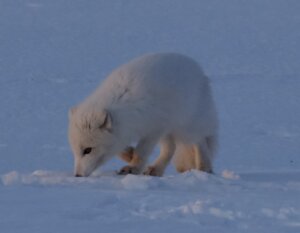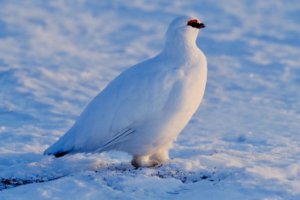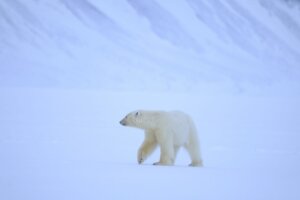×

“To seek solitude during the dark part of the year in Svalbard isn’t just about bidding farewell to civilization for several months. It’s first and foremost about daring to meet yourself.
Only the bravest among us dare to do that” — Arne O. Holm
Its December and a time when we all have some expectations. All things being equal Santa might be readying his sled and reindeer ready, to depart for his yearly pilgrimage south. We are living in a time of great change.
It’s not as cold as it should be this time of year. There has been a lot of rain and the reindeer are having a hard time. There is more ice around Bamsebu than snow – that makes it difficult for the reindeer to find food. The reindeer must be very hungry and we feel for them.
Last summer they counted 171 dead reindeer. There is a population of about 22,000 on Svalbard according to Åshild Ønvik Pedersen a scientist with the Norsk Polar Institutt who has been in charge of reindeer surveillance on Svalbard.
“Every day I am at work I think about how lucky I am. Thankful to be working on this and at the same time, feeling the affects of climate change deep in my body- these have had the greatest impact on me” — Åshild Ønvik Pedersen
The reindeer are going higher up to forage for food that is becoming increasingly more difficult in lower elevations due to early rains and ice blanketing the ground and their food sources.
Last year the reindeer had plenty to eat, the winter was colder and the snow came. This year is more like prior years with early rains – a bad sign for the coming winter and wildlife. Reindeer in Svalbard have a vital role to play; they forage, they discharge and this in turn pollinates the tundra for more growth.
The Arctic fox is another story as they will likely thrive this year. Reindeer carcasses being one of their staples. Eva Fuglei a fox researcher in Svalard shares that the fox are small hearty animals weighing in at approx. 2.5- 5kg. At this time of year they are complete with their white winter coat and can travel great distances – often crossing sea ice and islands to reach new continents.
Last year Eva had tracked one that made the distance from Svalbard all the way to Canada! The oldest fox on record lived to be 16. It’s not an easy life for them here in the Arctic, but they don’t have any natural enemies. Starvation during the winter is the main cause of death as we witnessed last year with several dead foxes close to Bamsebu.
With our moonlight headlamps and an infrared night vision scope, we are constantly scanning for wildlife. Looking for signs of change, how many, behaviour, size etc.
Suddenly with one last swipe before heading back to Bamsebu; there they were- the image two Polar bears- a female and last years young walking down from the hillside, about 700 metres ( 2000 ft) from us. We were on foot so we made our way back to our hut in the dark and in the silence of the Polar Night. We are never alone!
Education lesson 10th of December: Polar Bear Moms and Cubs
Education lesson 15th of December: Polar Bears in Svalbard
The sponsor of the month, Canada Goose, our Legacy Partner BRP and Marlink Satellite Communication, our provider for all video hosted calls.



Thanks for the updating! I love nature and this planet but I’m in love with polar regions…it’s amazing what you are doing! Thank you!
Thank you so much for your feedback Sara!
Yikes! Wonderful to see but no doubt those bears were hungry. Stay safe out there.
We will!
Thinking of both of you and hoping the long days ahead move quickly for you. This “second round” can’t be easy for either of you … your commitment and dedication to being the “boots on the ground” in such a beautiful and delicate … yet inhospitable place, is beyond remarkable. You are brave and crazy gals… but such an asset to the community that cares for our planet and brings awareness to all of us. Thank you once again for sharing your adventure and infusing us with hope and inspiration . Much love to you both… stay safe. 💕🇨🇦
And thank YOU so much for much appreciated words!
I think it must be beautiful there. I feel very sad about the reindeer and the Arctic in general. Thanks for all that you do, and share with us.
The Arctic is beautiful- and so is the rest of the World. We’ll do over best for climate change! Grettings from two stubborn optimists at Bamsebu
Amazing!
<3
So love reading every one of your blogs. Feel incredibly fortunate to know you both and so grateful for the work you’re doing. I share your site with everyone I know, hopefully it’s catching on.
Love and deep respect. Xo
Thanks for spreading the words and vibes out Kori 🙂
Hello, we read about you in Highlights children’s magazine. There are pictures of you and the Arctic in the article. How many pairs of wool socks do you wear at one time? 😇
I am 5.5 years old and I live in NYC.
Hi Eli, We always wear one pair of wool sock & slippers inside the hut and we sleep in our wool socks. When we go outside we have the one main pair of wool socks that we always have on and then one extra thick pair of wool socks inside heavy duty boots. We don’t use cotton socks at all since they are not helpful at keeping you warm 😊 Thanks for your question!
interesting to know about the reindeer and foxes, thank you for regular updates
Dear Ice Ladies!
I follow your actions from the beginning and appreciate what you are doing. First of all the inspiration you send in the world. Supporting the good things, good thoughts, good changes.
As you do, I love the silence. The kind of shelter, the silence can give.
And for this special days in December I send you a poem, I like so much. I can only write it down i German, but I hope you will be able to read it in English:
Vom Winter lernen
der Stille zu vertrauen
der Sprengkraft des Unsichtbaren
und dem Sammeln in den Kammern
während der Brachzeit
Vom Winter
wieder lernen
sich überschneien zu lassen
ohne Furcht.
von: Eveline Hasler
Best wishes and love from Germany
Gaby Grund